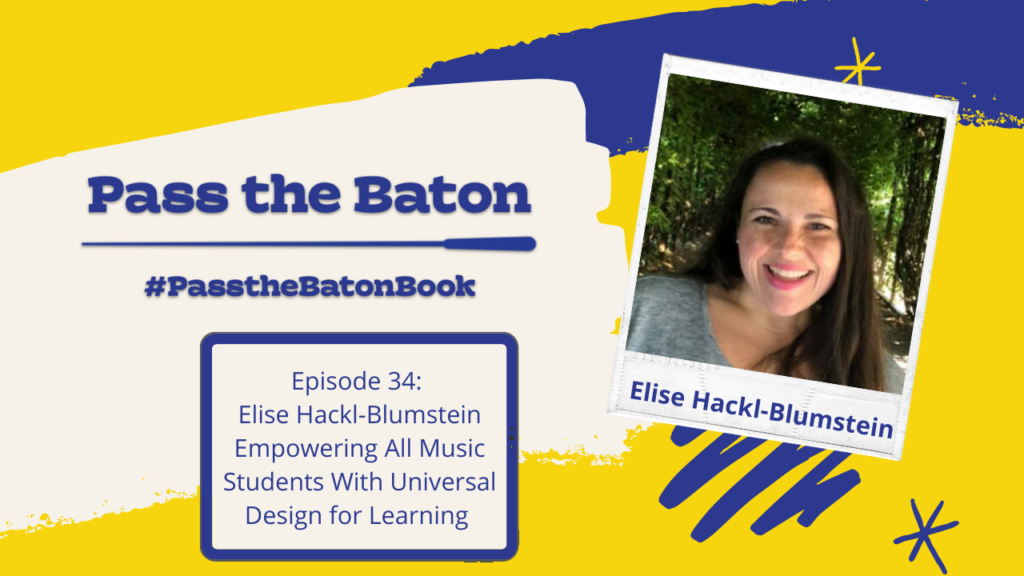In episode 34, we talked to Elise Hackl-Blumstein, a former accessible music educator and current student-services coordinator in Buffalo Grove, Illinois. Elise has experience teaching preschool through eighth grade music, and also has created an accessible arts organization focused on accessibility in all arts. She is passionate about making sure all students have access to music and music education. In this interview, Elise shares how Universal Design for Learning (UDL) is a beneficial framework for teaching all music students.

What is Universal Design for Learning?
Elise describes Universal Design for Learning as multiple means of engagement, action and expression, and representation. Engagement refers to student interest and self-regulation. Representation has to do with student comprehension. Action and expression refer to communication and executive functioning. UDL is a way of making sure spaces are accessible from the start. The accommodations and modifications in place for specific students are also available for students for any students who may benefit from them. Elise reminds us that even if there aren’t students with IEPs or 504 plans in our classes, everyone should have access. Accessibility isn’t just for people with disabilities, it’s for everybody. UDL enables us to reach even more students. Often when we think students are choosing not to take part, the real issue is they don’t have the access to participate.
Voice and Choice
While UDL starts with voice and choice, there are some things to remember. Everybody has a voice and we’re there to support that, but that may mean giving processing time or waiting time for students to understand the question. Sometimes a visual cue is necessary. And it’s possible students may have a way of responding that’s different from how you would do it. When thinking about giving choices, Elise suggests limiting options to two or three choices so students don’t get overwhelmed.
Elise offered numerous ideas about how teachers could create environments where all students had access and the ability to take ownership of their music making. Some of those included:
- Understanding that accommodations refer to how we do something. With an accommodation, the end goal is the same, but there are many ways to get there.
- When assessing students, we have to think about what the goal is. What do we want to see they can do?
- It’s not only okay, but it’s a good idea to ask students what they need, recognizing that students deserve that agency.
- UDL and SEL are a perfect partnership, since both focus on identity, belonging, and empowerment.
- As music teachers, we’re not alone in trying to meet the needs of our music students. We should talk to the other specialists in the building (the IEP team, occupational therapist, speech therapist, etc.) for help and to learn what accommodations are already in place.
- Behavior is communication. Often “unwanted behaviors” are students demonstrating they don’t have access to what we are doing. And young students especially can’t always tell us that with words.
People want to be treated like people, and when we can use tools like universal design, we can provide that tool that says you’re welcome here. I see your differences; I recognize them; I appreciate them, and we’re going to make this work for you.
What Can Teachers Try Tomorrow?
Elise had several suggestions for things music teachers could try tomorrow. First, when looking at the day’s lesson plans, ask yourself “can all of my students physically do this?” Consider the physical expectations in the lesson, and if all students have those capabilities. Second, remember that everyone takes in information differently. Try adding a visual when explaining something new to help build comprehension. Third, share the class schedule with students so they know what to expect during that class period. Many students will be able to participate more if they know what’s coming.

Be sure to check out the full interview on YouTube or your favorite podcast platform: Empowering All Music Students With Universal Design for Learning
You can connect with Elise and learn more about her work here:
- Instagram: @accessibleclassrooms
- Website: Elise Hackl-Blumstein
- Resource library (with lots of freebies): Accessible Music Store
- TPT (with lots of freebies): Accessible-Music-Room
- Ebook: Sensory Symphony
- Ebook: Our Voices, Our Song
- FREE Music ConstructED lesson: Accessible Composing In the General Music Classroom
- SEL Portraits Book: Teaching Music With Heart
- Keep an eye out for upcoming texts, to be released in Fall 2022 and Fall 2023!
Listen to the full interview on your favorite podcast app or here, on Anchor!
Check out these interviews to learn more about empowering all students in your music classroom:
- Episode 27: The Connection Between SEL and Student Empowerment, with Dr. Scott Edgar
- Episode 28: The Connection Between Culturally Responsive Teaching and Student Ownership, with Ashley Cuthbertson
- Episode 24: Empowering English Language Learners, with Dr. Angela Ammerman




